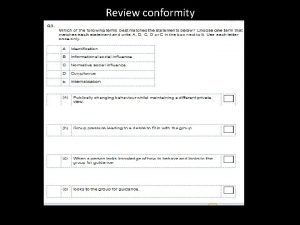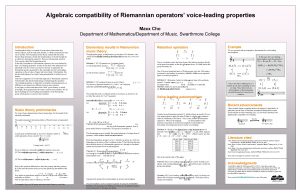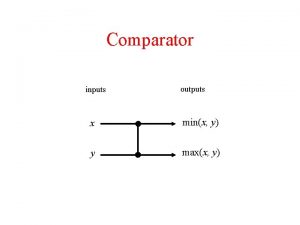Rage Fury MAXX Rage Fury MAXX The Answer





























- Slides: 29

Rage Fury MAXX™

Rage Fury MAXX™ The Answer to today’s 3 D dilemma High performance AND High quality AND Universal application acceleration

3 D Tradeoff • The classic hardware trade-off – Speed (Frame Rates) – vs. Quality (Resolution, Color Depth, Texture Size) – vs. Scene Complexity (Triangle Count) • Software community lag Creates user confusion and frustration

Why High Resolution Gaming? • Increased realism – Flight sims, FPS’s, sports – High resolution eliminates jaggies and need for antialiasing • Improved playability – Strategy games • View larger fields in greater detail – Flight sims, FPS, sports • Able to see finer detail and respond earlier • Increased Satisfaction – Enjoy better “eye candy”

Traditional Solutions • • 3 D pipe parallelism Faster engine clocks Higher memory bandwidth More of the 3 D Pipe - e. g. T&L Each of these options have advantages and limitations

3 D Pipe Parallelism • Setup engine – More triangles per second • Rendering engine – Multiple pipes, single pass multi-texturing – More rendered pixels per second • Both result in larger dies • Implications – Decreased yield due to larger die – Increased complexity lowers clock speeds – Process technology limits cost effective die size

Faster Engine Clocks • Design for 150+ MHz increases engine throughput (triangles and pixels) – Decreased yield at speed – Limits ASIC complexity – Process technology limits cost effective engine speeds • Simpler architectures are easier to push

Higher Memory Bandwidth • Design for higher speed memories increases rendering bandwidth – 166 MHz or faster SDRAM or DDR SDRAM • Enables high frame rates at high resolutions • Implications – More costly memory – More exotic memories not in mass production – Lower ASIC yield (as for higher engine clocks)

More Pipeline - T&L • Offload CPU with Transform and Lighting acceleration on ASIC • Increases scene complexity through higher supportable triangle count • Implications – Larger die - lower yield – Higher complexity - lower speed in a given technology (. 18 micron is where it becomes viable) – Must wait 8 -12 months for software to take advantage of this

The ideal gaming solution would • Support higher resolutions and color depths for games over the next 12 months with • A balanced approach to – – Clock speeds (memory and engine) ASIC size Parallelism Transparent software support • . 25 micron technology for high quality, high volume production

The solution. . . ATI MAXX™ (Multiple ASIC) Technology

Mass Market Multiple Chip Processing Techniques • 3 Dfx’s Scan Line Interleave (SLI) • Metabyte/Wicked 3 D Parallel Graphics Configuration (PGC) • ATI’s MAXX™ (Multiple ASIC) Technology

Scan Line Interleave (SLI) Issues • Required specific chip design • No AGP support • Sychronization delays • ASIC’s cannot work ahead (inefficient design) • No DAC calibration

Parallel Graphics Configuration (PGC) - Split Frame Rendering Issues • Bus imbalance (PCI vs. AGP) • Imbalanced load – Scene complexity in top half typically lower than bottom • ASIC’s cannot work ahead • Image tearing • No DAC calibration

Software Community Lag • Software community lags hardware – – API support and game engine develop lags Optimizations unique to each chip Reduces ISV development and support cost User unable to realize full acceleration capabilities (eg. geometry) • User and channel confusion with 3 D software support

AURORA Project Goals • Develop a patentable technology that demonstrates ATI’s technology and performance leadership • Using multiple (2) current ATI ASICS • on a single AGP board • With transparent support for Open. GL and D 3 D applications • Architecture that supports future ATI ASICS

“Difficult” Problems • • • “Bridgeless” Design Driver transparency Frame/texture/rendering management Page flip synchronization DAC calibration Efficient use of each ASIC Desire for a simple, quality design that could be leveraged with future ASIC’s

Block Diagram 32 MB SDRAM RAGE 128 PRO GL DB-15 RGB out RAGE 128 PRO GL

ATI Multiple ASIC Technology Patent Pending Each engine renders alternate frames Engine rendering load is cut in half Engine rendering capacity is doubled

MAXX™ Performance • Alternates frame rendering between ASICs for a very efficient use of resources - each frame does half the work • Render ahead if required -- engines do not have to wait for each other as is the case with SLI and split frame techniques • Can be fully decoupled for single ASIC software and OS compatibility

Performance Con’t • High fill rate, 500 Mpixels/sec • Superior memory bandwidth: 4 GB/sec • Run full speed in 32 bpp hi-res modes with large 64 MB (dual 32 MB configuration) • Performance achieved with standard, readily available production parts

3 D Community Lag RAGE FURY MAXX™ accelerates all D 3 D and OGL applications – No changes needed to games – Accelerates past, current and future generations of applications – ATI drivers split rendering and display activity without software invention

Target Market • High-end gamer who is passionate about: – – – – Frame rate (speed, power) Game optimization Frame buffer size Benchmarks Resolution Maximum visual stimulation Latest games

Rage 128 Pro Advantages • Rage Fury MAXX™ operates like a Rage Fury Pro in 2 D mode – – Stable, high volume quality Superior 2 D performance Leadership Video features and quality Integrated HW DVD

Key Selling Features • FASTEST Game Frame Rates Today – Multiple ASIC technology and true colour rendering performance for ultimate speed • High Resolution, True Color Display • 64 MB memory – for photo realistic game play with massive textures · ATI MAXX™ Technology

Rage Fury MAXX™ Strengths • 32 bit true color for highest quality – Multitexturing requires 32 bpp in order to avoid color banding or flat washed out colors – Highly realistic blending and lighting effects – Quality without a compromise in frame rates • High fill rates (> 500 megapixels/sec. ) required for rendering at true color, 1280 x 1024 and 1600 x 1200 resolution • Ideal for high resolutions and high color depth

Limitations • Performance benefits reduced below 1024 x 768 resolution compared to single ASIC solutions • 64 MB is configured as two 32 MB frame buffers • 2 nd ASIC does not assist 2 D performance

ATI Rage Fury MAXX™ vs. Ge. FORCE 256 The MAXX™ advantage: • Faster performance especially in 32 bit mode • More memory for the same price as opposed to less memory with T&L. Games require higher fill rates in high resolution and not much from geometry.

The Future • More driver performance enhancements • Possible higher clock speeds • Future ASICs on MAXX™ platform ATI MAXX™ Technology will continually provide the leading edge gamer with the best game experience
 The boy in the striped pajamas the fury
The boy in the striped pajamas the fury The sound and the fury themes
The sound and the fury themes Ape like fury
Ape like fury Mr hyde key quotes
Mr hyde key quotes The sound and the fury plot
The sound and the fury plot Suffix for fury
Suffix for fury Fire-eyed fury metaphor
Fire-eyed fury metaphor From the fury of the northmen deliver us
From the fury of the northmen deliver us Hình ảnh bộ gõ cơ thể búng tay
Hình ảnh bộ gõ cơ thể búng tay The pearl vocabulary
The pearl vocabulary Rage to reason amy buie
Rage to reason amy buie Romeo and juliet prolog
Romeo and juliet prolog Ng-html
Ng-html Bổ thể
Bổ thể Tỉ lệ cơ thể trẻ em
Tỉ lệ cơ thể trẻ em Chó sói
Chó sói Chụp tư thế worms-breton
Chụp tư thế worms-breton The rage dont
The rage dont Caged bird metaphors
Caged bird metaphors Hát lên người ơi alleluia
Hát lên người ơi alleluia Các môn thể thao bắt đầu bằng từ đua
Các môn thể thao bắt đầu bằng từ đua Thế nào là hệ số cao nhất
Thế nào là hệ số cao nhất Physical signs of anger
Physical signs of anger Các châu lục và đại dương trên thế giới
Các châu lục và đại dương trên thế giới Công thức tính độ biến thiên đông lượng
Công thức tính độ biến thiên đông lượng Trời xanh đây là của chúng ta thể thơ
Trời xanh đây là của chúng ta thể thơ Mật thư anh em như thể tay chân
Mật thư anh em như thể tay chân Phép trừ bù
Phép trừ bù độ dài liên kết
độ dài liên kết Các châu lục và đại dương trên thế giới
Các châu lục và đại dương trên thế giới





















































